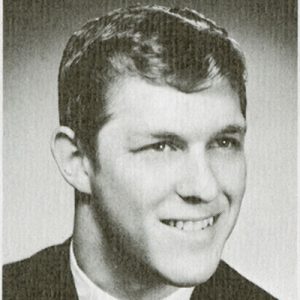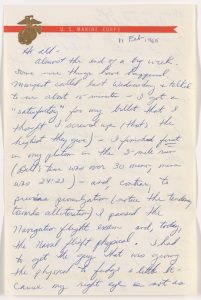
Robert A. “Bob” Seiple ’65
(Captain, U.S. Marine Corps, 1967–1969)
When Bob Seiple started Brown in 1961, chapel was mandatory and men still wore neck ties to dinner. Yet for Seiple, a small town boy who’s hometown of Harmony, New Jersey was a close-knit and deeply religious community, campus life was still a bit of a culture shock. “My faith was and is important and I never had to argue it into existence until I came to Brown,” he recalls, “explaining the articulation and the formation of faith to someone else, was not something I ever wrestled with in Harmony, New Jersey. We all read the same Bible, underlined the same notes, and went to the same church.”
Bob had chosen Brown over Rutgers and Delaware at the encouragement of a football coach. For three years, Seiple and classmate John Parry ’65 made a “terrific end combo” for the fighting Bruins according to Brown University Sports Historian Peter Mackie. In fact Bob’s happiest memory from his undergrad career at Brown was when he landed a touchdown catch at an away game at Colgate his sophomore year. He also played lacrosse all four years at Brown. Aside from his faith being challenged and the fact that “no one liked my [his], writing style,” Bob remembers no sad times at Brown.
In May of 1965, having graduated with a degree in American Literature, Bob headed to Europe for the summer, and on the way back met the woman who would become his wife. Upon returning, however, he was also met with a letter from his draft board. “I didn’t want to be drafted,” he explained, “so I decided I would go into the service on my own.” He choose the Marines because “they seemed to be the best. It’s not just because they have great uniforms. They just took things seriously and anybody can go into the Army and the Navy. So I decided to go into the Marine Corps.”
Seiple began his career with the Marines in January of 1966 at the Officer Candidate School (OCS) at Quantico. The transition to military life was difficult: “for the first three days I felt I had made a huge mistake and that it was irreparable,” Seiple recalls. “It was very depressing.” Letters from Seiple’s parents, siblings, pastors, and schoolchildren from his hometown poured into the OCS almost daily, smoothing the transition. Eventually, he recalls “I began to enjoy the cadence of it all, the emphasis on discipline, the physical things, which were easy for me at the time, the marching, which had a nice structure for a Type A personality.” Eventually, he finished the ten-week training as platoon honor man, and chose to become a pilot. He “saw the aviation aspect as another education that I would be stupid to give up, or not take advantage of, if it were offered,” he says.
There was still the matter of his fiance’ Margaret Anne, who he had proposed to after spending only thirteen days together. The couple decided to get married before Bob had to report to pre-flight training at Pensacola. “There was a war on” Bob recalls, “I was in training and there was no question in anybody’s mind, my wife or mine, that as soon as the training was done I would get into a squadron and be sent overseas.” In October of ’67, Seiple met his six month pregnant wife on a tarmac in Moline, Illinois in the pouring rain and watched her wave goodbye as the plane took off to take him to the west coast. From there he would travel to the Philippines, then Okinawa, and then spend thirteen months in Vietnam.

Although pilots lived more comfortably than infantry soldiers, there was still danger waiting every day. Seiple and his squadron lived in hooches and he remembers hearing bullets go over and through their tin roofs. Stationed in Da Nang, Bob recalls many rocket attacks at night, which resulted in losing “more airplanes on the flight line [on the ground] through direct hits than we lost over North or South Vietnam.” He remembers that “the first three weeks I was there we had two planes shot down, lost two crews, and I lost two roommates. We had fifteen crews for thirteen months. If you do the math, losing two in three weeks—the pucker factor was very, very high.”
Again, Bob turned to letters home for comfort. Dozens of letters brought news from Harmony to Da Nang. Reports from the town where cows outnumbered people was gravely different than the letter he sent back home, struggling to portray the realities of war without giving his folks reason to worry. In a letter sent on October 27, 1968, Seiple informs the family he was awarded a medal for a truck destroying mission in North Vietnam. “It’s been a wonderful year though, like I’ve said many times, and I’ll have experiences that will last a lifetime. And something no one will be able to take away from me. I’m very thankful.”
After many close calls, and successful missions, Seiple returned to the states in 1969. After instructing down at Cherry Point, North Carolina, he returned to Brown University in 1971. When Seiple returned, Brown had changed dramatically. At age 32, he became Brown University’s youngest Athletic Director, a position he held from 1975-1979, when he moved into the role of VP for Development. As Peter Mackie, Brown’s Sports Historian, observes, Seiple was a very able guy who presided over a kind of renaissance for Brown athletics: Brown won its first Ivy title in football in 1976, (after a low period in the ’60s), and basketball improved its image with several outstanding players. He also presided over the emergence of strong women’s sports at Brown after Title IX.
Disturbed by the lack of religious freedom he had seen in Vietnam, Seiple was determined to make a difference. He went on to serve as president and CEO of the Council of America’s First Freedom, and served for eleven years as the president of World Vision, Inc. He also spent four years as president of Eastern College and Eastern Baptist Theological Seminary (now Palmer Theological Seminary). After that, he spent two years in the State Department as the U.S. Ambassador-at-Large for International Religious Freedom. He is also founder and chairman of the board of the Institute for Global Engagement. He is the author of two books:, “A Missing Peace” and “Ambassadors of Hope.”
As of 2011 Bob Seiple was retired, but still served as an ambassador for International Religious Freedom.
